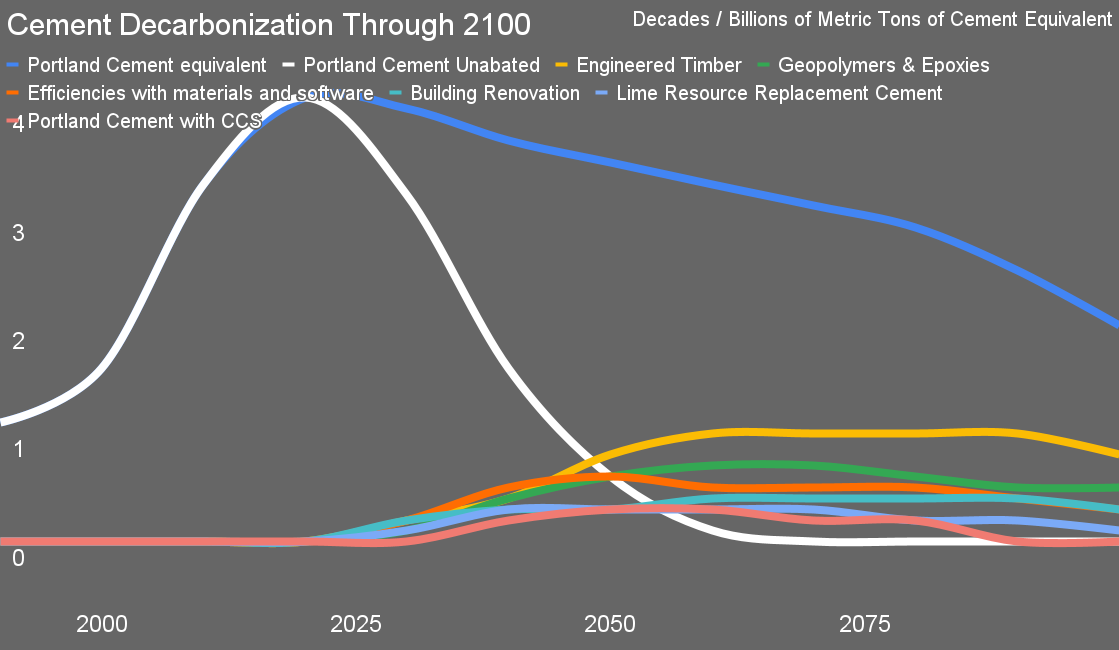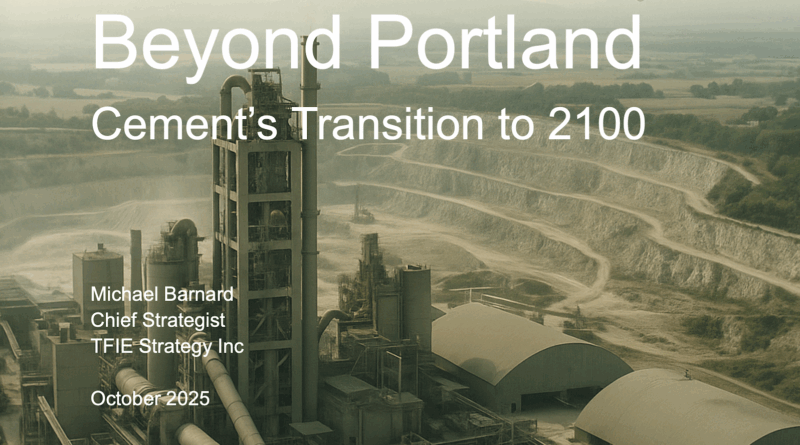From Gray Glue to Green Foundations: Cement’s 2100 Transition
Support CleanTechnica's work through a Substack subscription or on Stripe.
The publication of the white paper Beyond Portland: Cement’s Transition to 2100 by TFIE Strategy Inc comes at a moment when the cement and concrete industries stand at the center of the global climate challenge. Cement is everywhere—in the foundations of homes, the bridges that span rivers, the ports that connect economies, and the wind turbine bases that anchor renewable energy. It is also one of the largest single industrial sources of carbon emissions, responsible for nearly 10% of global CO2 output. The task ahead is to keep the benefits of this essential material while removing its carbon burden. The report brings together years of technical, economic, and policy analysis to chart how that transition can unfold through the rest of this century.

The solutions are already known in outline. The first is electrification of process heat. Cement kilns have long been fired by coal and natural gas because they were cheap and accessible, but their combustion releases both direct and process emissions. New high-temperature electric heating technologies—plasma torches, induction systems, and resistive elements—can supply the same heat without fossil fuels. Once kilns are electrified, the CO2 that comes from the limestone itself is easier to isolate, making carbon management more practical. As the price of renewable electricity continues to fall, electric heat will not only be cleaner but increasingly competitive, especially as carbon pricing rises and fossil fuels lose their advantage.
Another major pathway is the replacement of Portland cement with alternative binders. A range of materials can substitute for or supplement traditional clinker: calcined clays, geopolymers, alkali-activated slag, and even certain types of recycled concrete. Each offers a different chemistry for binding aggregates, often using industrial by-products or abundant minerals rather than limestone. Calcined clay systems such as LC3 reduce process emissions by as much as 40%. Geopolymer cements, made from coal fly ash, blast-furnace slag, or red mud from aluminum refining, can cut emissions even further while providing higher chemical resistance. These technologies are mature enough for commercial deployment but need harmonized standards, consistent quality testing, and policy support to scale.
A third set of solutions focuses on cutting the sheer quantity of cement that societies consume. Demand reduction is a powerful lever, achievable without compromising living standards. Building design software can now model stress loads and optimize structures, reducing unnecessary over-design that wastes concrete. Generative design and finite-element analysis are becoming standard tools that minimize material use while maintaining safety. Reuse and retrofitting of existing buildings extend the life of structural materials already in place. In many urban centers, adaptive reuse is replacing demolition and new construction as the more cost-effective, lower-carbon strategy.
Material substitution is another key trend. Engineered timber, often called mass timber or cross-laminated timber, is gaining traction as a structural replacement for concrete in low- and mid-rise buildings. A cubic meter of mass timber stores about a ton of CO2 absorbed from the atmosphere and can replace several tons of concrete in the same structure. When combined with concrete only where essential—for foundations and in some cases load-bearing cores—mass timber can halve the total emissions of a building project. The technology is spreading quickly through Europe, North America, and parts of Asia, supported by changes to building codes and insurance frameworks.
The concrete industry also has untapped potential in circularity. Concrete waste from demolished buildings can be crushed and reused as aggregate, cutting the need for new sand and gravel. Steel reinforcement can be recovered and melted in electric arc furnaces powered by renewable energy. Emerging electrochemical processes, such as those being developed by Sublime Systems, can even recover lime from waste concrete or steel slag without producing additional CO2. These loops transform what was once industrial waste into feedstock for new materials, lowering both cost and environmental impact.
Carbon capture has a limited but important role. While many pilot projects have failed to deliver on cost or performance, certain configurations make sense. If kilns are electrified and the CO2 stream from limestone is already pure and pressurized, capturing and storing that gas may be viable where storage geology is nearby. It will not be a universal solution, but it can complement electrification and material substitution in regions where other options are less practical. The goal is to deploy capture only where it makes economic sense, not as a blanket fix for an industry that can change in more fundamental ways.
Policy frameworks will determine how fast these solutions move. Carbon pricing is one of the most effective tools, aligning economic signals with environmental outcomes. When carbon costs rise to the level of the social cost of emissions—around $200 per ton of CO2 in Europe’s 2030 guidance—electrified kilns, low-carbon binders, and recycled materials all become competitive with conventional cement. Regulations on embodied carbon in building codes reinforce this by requiring developers to account for the full life-cycle emissions of materials. Public procurement can accelerate adoption by specifying low-carbon concrete and engineered timber for infrastructure projects, creating predictable demand and economies of scale.
Financial and institutional changes are also part of the transition. Banks and insurers are starting to treat carbon exposure as a material risk, which makes high-emission cement production less attractive for long-term investment. Developers are learning that sustainable materials can command higher asset values, especially as tenants and buyers favor low-carbon buildings. Workforce training is adapting as well, preparing engineers and tradespeople to work with new materials, software, and standards. These shifts are incremental but cumulative, and they reshape the entire construction ecosystem.
The cement industry’s future will not be defined by one technology but by the interplay of many. Electrification, new chemistry, circular material flows, smarter design, and the intelligent use of carbon pricing form a portfolio of solutions that together can cut emissions from the sector by more than two-thirds before mid-century. By 2100, cement production is likely to look nothing like it does today. Portland cement will remain in use where its specific properties are essential, but its share of total binding materials will fall sharply as geopolymers, alternative clays, and bio-based options take its place.
The path outlined in this report is demanding but achievable. The science is clear, the technologies are proven, and the economic case strengthens each year as renewable energy becomes cheaper and climate policy more consistent. What remains is coordination—between governments setting the rules, industries deploying the technology, and investors financing the change. Beyond Portland Cement’s Transition to 2100 offers a framework for that coordination, showing that decarbonizing the world’s most ubiquitous construction material is not a dream of the distant future but a practical project already underway.
The challenge now is to move from pilots to full-scale transformation. The gray glue that built the modern world can become part of the solution to the climate crisis, not its symbol. Every ton of low-carbon cement produced, every building redesigned to use less of it, and every substitution of timber or recycled material marks a step toward that outcome. The solutions are at hand; the task is to apply them with consistency, urgency, and ambition.
Sign up for CleanTechnica's Weekly Substack for Zach and Scott's in-depth analyses and high level summaries, sign up for our daily newsletter, and follow us on Google News!
Have a tip for CleanTechnica? Want to advertise? Want to suggest a guest for our CleanTech Talk podcast? Contact us here.
Sign up for our daily newsletter for 15 new cleantech stories a day. Or sign up for our weekly one on top stories of the week if daily is too frequent.
CleanTechnica uses affiliate links. See our policy here.
CleanTechnica's Comment Policy

